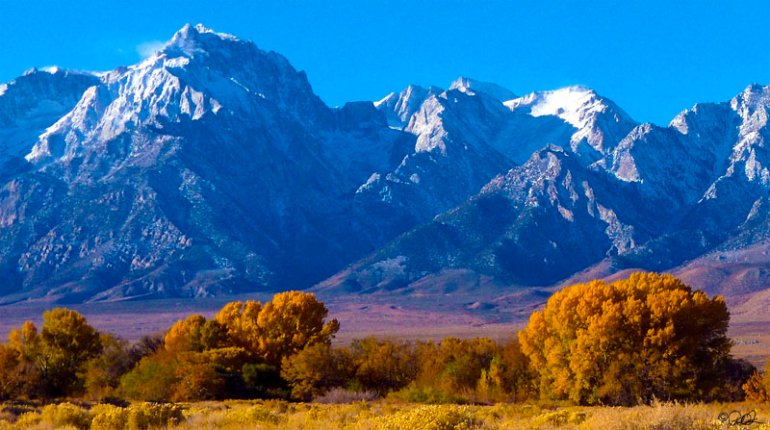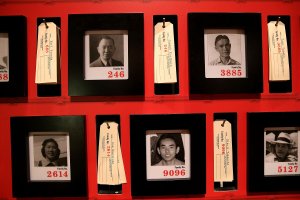
In the closing days of World War II, a Japanese American set out with other men from the infamous internment camp at Manzanar on a trip to the mountains, where he went off on his own to paint a watercolor and got caught in a freak summer snowstorm.
A hiker found Giichi Matsumura’s body weeks later amid a jumble of boulders, and he was laid to rest in a spot marked only by a small stack of granite slabs.

Over the years, as the little-known story faded along with memories, the location of Matsumura’s burial in the remote and forbidding alpine landscape was lost to time, and he became a sort of ghost of Manzanar, the subject of searches, rumors and legends.
Now, 74 years later, his remains may have finally been found.
The Inyo County sheriff’s office told The Associated Press it is investigating the possibility that a skeleton discovered earlier this month in the high Sierra Nevada is Matsumura’s.
If those suspicions prove correct, Matsumura will have the rare distinction of having been lost and found twice.
His fate is a footnote to one of the darkest chapters in U.S. history, when more than 110,000 Japanese Americans were deemed a security risk and herded into prison camps in remote locations.
Matsumura, a 46-year-old gardener from Santa Monica, was among about 10,000 who ended up in Manzanar, living behind barbed wire about 185 miles (298 kilometers) north of Los Angeles in a place blazing hot in summer and frigid in winter.
Some of the men began sneaking out at night to go fishing for days at a time, evading the spotlight from a guard tower manned by soldiers with machine guns, said Cory Shiozaki, director of the documentary “The Manzanar Fishing Club.” The anglers would slip back into the camp with big trout caught in the streams and lakes around Mount Williamson, California’s second-highest peak at 14,374 feet (4,381 meters).
Unlike the early days of the clandestine outings, there was no security on July 29, 1945, when Matsumura tagged along with six to 10 fishermen on the arduous trek to a chain of lakes beneath the mammoth peak.
At the time, Germany had surrendered, and the U.S. was days away from dropping the first of two atomic bombs on Japan that ended the war. People were allowed to leave Manzanar, and the population had dropped by half, said Brian Niiya of Densho, an organization dedicated to preserving the history of Japanese internment.
Many stayed behind, however, because their homes had been taken or they feared racism and violence upon their return.
“It was kind of a black comedy,” Niiya said. “They were trying to close the camps and people didn’t want to leave. They heard how bad things were on the outside.”
On the night the snowstorm blew in, the other fishermen took shelter in a cave, and when the weather cleared, they couldn’t find Matsumura. Two search parties spent several days looking for him but found only his sweater, Shiozaki said.
A month later, Mary DeDecker, a botanist and avid hiker, spotted the remains and reported her find to authorities. A burial party from the camp ascended the mountain, located the body and buried it.
“It was before the days of helicopters,” said DeDecker’s daughter, Joan Busby. “They left him up there covered in stones and a blanket.”

(Credit: Justin Sullivan/Getty Images)
The camp’s newspaper, The Manzanar Free Press, reported the story Sept. 8, 1945, on the front page. Matsumura left behind a wife, a daughter, three sons, a brother and his father, all living in the camp.
It’s unclear if any family members attended the burial or ever returned to the site.
Robert Matsumura, who was born in the camp in 1944, said he only has foggy recollections of his uncle’s story, handed down to him by an older generation reluctant to discuss such things.
“There’s a saying: ‘Shikata ga nai,’ which means, ‘If you can’t do anything about it, let it go,'” he said.
Over the years, rumors surfaced of grave robbers, and there was a story that a motorcyclist in San Diego was stopped for driving around with a handlebar-mounted skull from the grave, said Bill Busby, DeDecker’s son-in-law.
Hikers have written on blogs about searching for the site, and Shiozaki said one of his cameramen looked in vain for the tomb during several trips.
Earlier this month, though, Tyler Hofer, a hiker from San Diego, got off course on his way toward the summit of Mount Williamson and spotted a bleached bone near a lake. He and a friend moved rocks away to reveal a skull and an entire skeleton on its back, the arms crossed in what seemed to be a burial pose.
Authorities downplayed speculation about foul play and disputed Hofer’s account that the skull was fractured. Sheriff’s spokeswoman Carma Roper said investigators will conduct DNA tests on the bones, a process that could take two to four months.
Matsumura’s wife, Ito, was 102 when she died in 2005. The last of their children, Masaru, died over the summer at 94, according to his son, Wayne Matsumura.
If the bones turn out to be those of his grandfather, he said, there is already a place for them: In a corner of Woodlawn Cemetery in Santa Monica, where his grandmother is buried, a black granite headstone bears her name and that of her long-lost husband.












